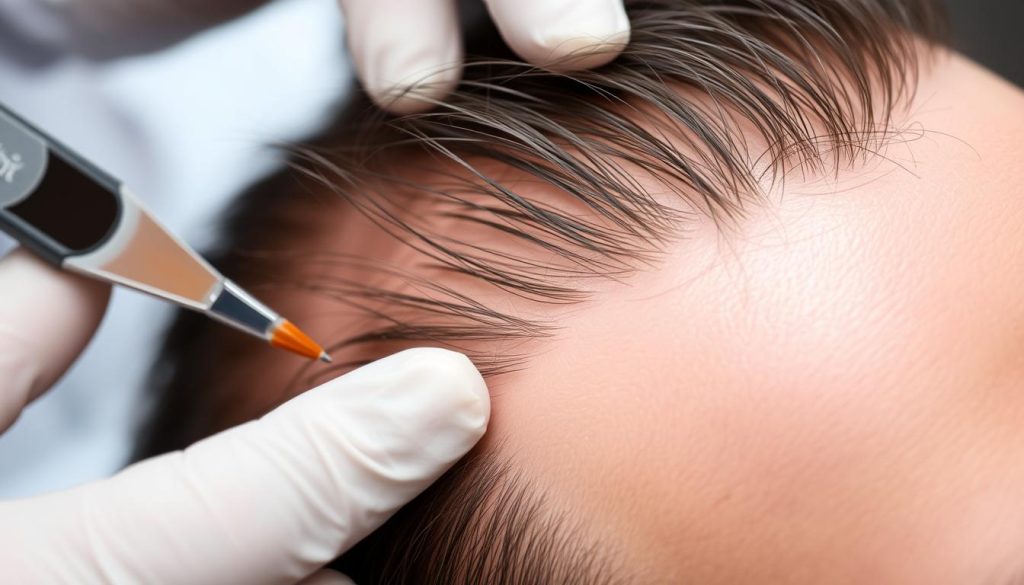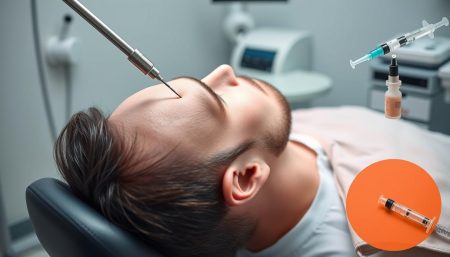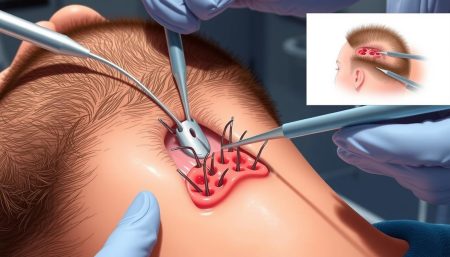Hair loss can really affect how we feel about ourselves. It can lower our self-esteem and confidence. But, hair transplant surgery offers a lasting solution. It has changed many lives, giving them back their natural-looking hair and confidence.
Hair transplant surgery is now a popular choice for both men and women. It moves healthy hair follicles to thinning areas. This makes the hair look fuller and more youthful. Thanks to new techniques and technology, the results look very natural.
In this article, we’ll look into hair transplant surgery in detail. We’ll cover everything from understanding hair loss to picking the right surgeon. If you’re thinking about this treatment or just want to know more, you’ll find useful information here.
Understanding Hair Loss and Its Impact on Individuals
Hair loss affects millions globally, causing distress. It prompts many to seek treatment. This condition impacts more than just looks, affecting mental health and social life.
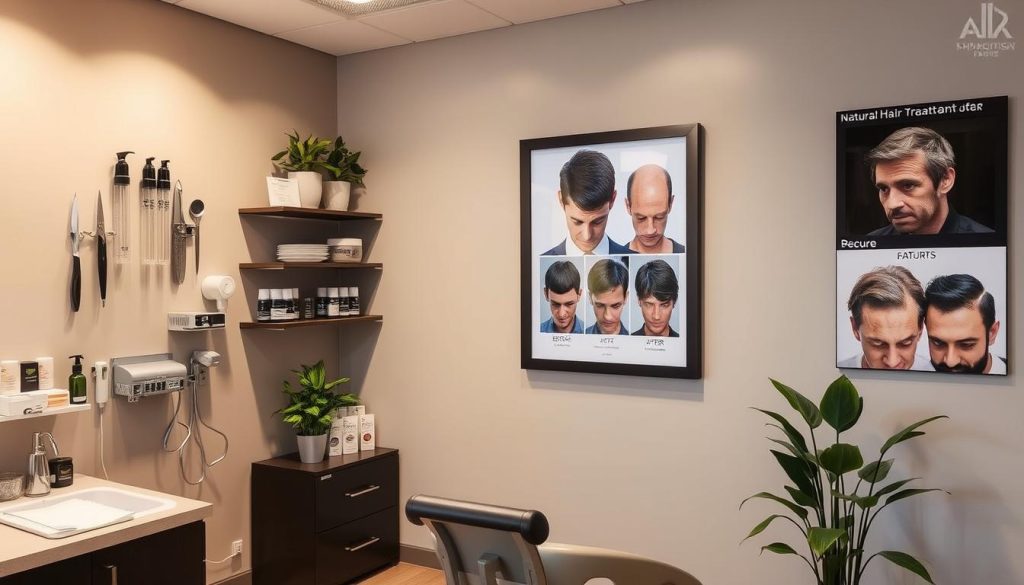
Common Causes of Pattern Baldness
Pattern baldness, or androgenetic alopecia, is common. It’s mainly due to genetics and hormonal changes. In men, DHT shrinks hair follicles. Women may experience thinning due to hormonal changes during menopause.
Psychological Effects of Hair Loss
Hair loss has a deep emotional impact. Many feel less confident, anxious, or depressed. These feelings often drive people to look for treatments, including surgery.
“Losing my hair felt like losing a part of my identity. It affected my confidence in both personal and professional settings.”
When Hair Loss Becomes a Medical Concern
Excessive shedding or sudden bald patches may signal a health issue. Conditions like alopecia areata, thyroid disorders, or nutritional deficiencies can cause hair loss. It’s important to see a doctor for a proper diagnosis and treatment.
| Hair Loss Type | Possible Causes | Recommended Action |
|---|---|---|
| Gradual Thinning | Genetics, Ageing | Consider hair loss treatment options |
| Sudden Hair Loss | Stress, Medical Conditions | Seek immediate medical advice |
| Patchy Hair Loss | Alopecia Areata, Fungal Infections | Consult a dermatologist |
What is Hair Transplant Surgery?
Hair transplant surgery is a modern way to fix hair loss. It moves healthy hair follicles from full areas to thin or bald spots. This makes hair grow again.
First, hair follicles are taken from the back or sides of the head. Then, they are carefully placed in thin or bald spots. This makes the hair look natural.
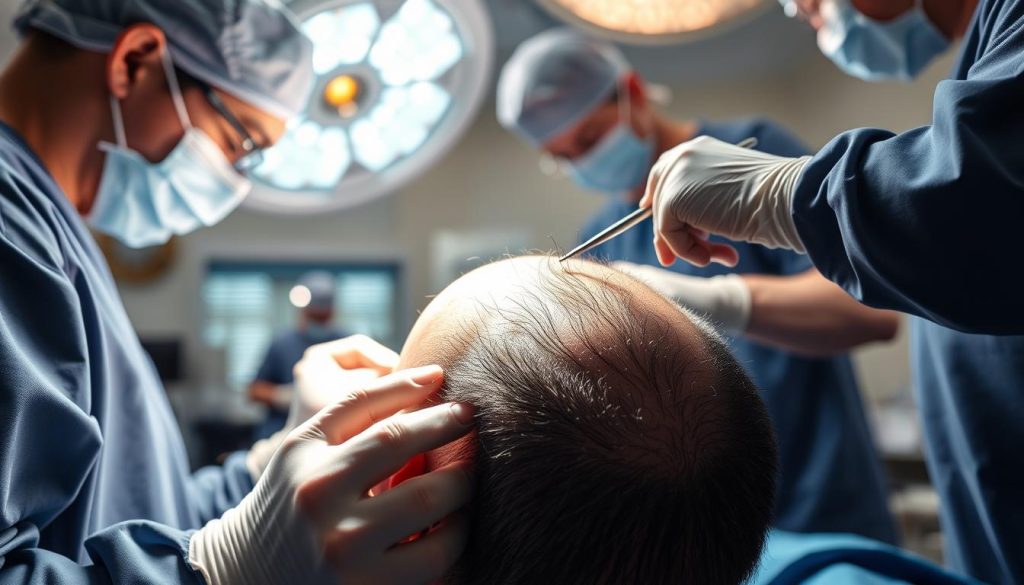
This surgery is different from wigs or hairpieces. It gives lasting results. The new hair can be styled, cut, and cared for like your own.
Hair transplant surgery has given me back my confidence. It’s amazing how natural the results look!
There are two main ways to do hair transplant surgery:
- Follicular Unit Transplantation (FUT)
- Follicular Unit Extraction (FUE)
Both methods aim to bring back hair. The choice depends on the patient’s needs and the surgeon’s advice.
| Aspect | FUT | FUE |
|---|---|---|
| Extraction method | Strip of scalp removed | Individual follicles extracted |
| Scarring | Linear scar | Minimal scarring |
| Recovery time | Longer | Shorter |
The Evolution of Hair Restoration Techniques
Hair restoration has made huge strides over the years. It now offers hope to those facing hair loss. Let’s look at how we’ve moved from old methods to new ones.
Traditional Strip Method (FUT)
Follicular Unit Transplantation, or FUT, was a key method in the past. It involved taking a strip of scalp from the back. Surgeons then split this into individual follicles for transplanting. Though it worked, it left a scar and took longer to heal.
Modern Follicular Unit Extraction (FUE)
The fue hair transplant changed the game. It takes individual follicles from the donor area. This method causes little scarring and heals faster. It’s now more popular for its less invasive approach and natural results.

Technological Advancements in Hair Transplantation
Recent years have seen big tech leaps in hair restoration. Robotic systems have made the process more precise and quicker. New graft preservation methods have also improved survival rates. These advances have made hair transplants more efficient and successful.
| Technique | Scarring | Recovery Time | Natural Look |
|---|---|---|---|
| FUT | Linear scar | Longer | Good |
| FUE | Minimal | Shorter | Excellent |
As follicular unit transplantation keeps improving, we can expect even better results in the future.
Evaluating Candidacy for Hair Transplantation
Not everyone is a good fit for hair transplant surgery. A detailed check by a skilled hair restoration expert is key. They look at many things that affect how well the surgery works.
Age is important. Young people might lose more hair, which could change the transplant’s success over time. The type and amount of hair loss also matter. Those with a lot of baldness might need more than one transplant to get the look they want.
Having enough healthy hair in the donor area is vital. This area is usually the back and sides of the head. People with thinning hair everywhere might not be good candidates.
- Overall health status
- Scalp flexibility
- Hair characteristics (colour, texture, curl)
- Expectations for the procedure
These factors help decide if hair transplant surgery is right. If it’s not, other treatments might be suggested. It’s important to have clear expectations and know that restoring hair takes time and care.
“A thorough check makes sure hair transplantation is the best choice for each person. It increases the chance of a good and happy result.”
The Science Behind Follicular Unit Extraction
Follicular unit extraction (FUE) is a groundbreaking hair transplant method. It has changed the way we treat hair loss. This technique is less invasive, making it a popular choice for many.
Understanding the FUE Process
The FUE process takes hair follicles from the back of the head. These follicles are then placed in the thinning areas. This method gives natural-looking results and leaves little to no scar.

Donor Area Selection and Management
Choosing the right donor area is key for FUE success. Surgeons pick areas with strong hair growth for the best results. They also manage the donor area well to keep it healthy after the procedure.
Graft Survival Rates
The success of FUE depends on graft survival rates. Several things affect these rates, including:
- Surgical skill and experience
- Proper handling and storage of grafts
- Patient adherence to post-operative care instructions
| Factor | Impact on Graft Survival |
|---|---|
| Surgical Skill | High – Proper extraction and implantation techniques |
| Graft Handling | Medium – Careful storage and hydration of grafts |
| Patient Care | Medium – Following post-operative instructions |
Thanks to better FUE techniques and technology, graft survival rates have gone up. This means patients get better and longer-lasting results from hair restoration.
Preparing for Your Hair Transplant Procedure
Getting ready for hair transplant surgery needs careful planning. You must follow your surgeon’s guidelines closely. This preparation is key for the best results from your surgery.
Your journey starts with a first meeting with your surgeon. They will look at your hair loss, talk about what you hope for, and explain the surgery. They will also give you specific instructions to follow before the surgery.
Before your surgery, you might need to change your lifestyle a bit. You might have to:
- Stop taking certain medicines that could affect the surgery
- Avoid drinking alcohol and smoking
- Use a special scalp care routine
- Take time off work to recover
As your surgery date gets closer, you might feel both excited and a bit worried. To calm your nerves, here’s a list of things to get ready:
| Item | Purpose |
|---|---|
| Button-up shirts | Easy to wear without disturbing grafts |
| Loose-fitting hat | Protects scalp when going outside |
| Neck pillow | Supports head during sleep |
| Pain relievers | Manages post-operative discomfort |
Remember, good preparation is essential for a smooth surgery experience. By listening to your surgeon and getting ready, you’ll be ready for your surgery and the recovery that comes after.
The Hair Transplant Surgery Process
Hair transplant surgery is a detailed process that needs careful planning and execution. This section explains the main stages of the procedure. It covers everything from pre-operative preparations to post-operative care.
Pre-operative Preparations
Before starting the surgery, patients go through several steps. The surgeon marks the area where hair will be transplanted and designs the new hairline. Local anaesthesia is given to keep the patient comfortable during the procedure.
Patients are told not to take certain medications. They also get specific instructions to help achieve the best results.
The Surgical Procedure
The FUE hair transplantation method involves taking individual follicular units from the donor area, usually the back of the head. These units are then carefully placed in the recipient area. The whole process is precise and can take several hours.
Post-operative Care
After the surgery, it’s important to take good care of the scalp for healing and results. Patients get detailed instructions on how to clean their scalp and manage any discomfort. They also learn how to protect the new grafts.
Follow-up appointments are set to check on the patient’s progress and answer any questions.
| Stage | Duration | Key Points |
|---|---|---|
| Pre-operative | 1-2 hours | Hairline design, anaesthesia administration |
| Surgical Procedure | 4-8 hours | Graft extraction, recipient site creation, graft placement |
| Post-operative Care | 2-3 weeks | Scalp care, follow-up appointments, initial recovery |
Recovery Timeline and Expectations
After hair transplant surgery, patients start a journey of recovery and hair growth. Knowing the timeline helps set realistic hopes and ensures proper care during healing.
The first days after surgery are key. Patients might feel some pain and swelling, which usually goes away in a week. It’s vital to follow the post-operative instructions well to help healing.
In the weeks after surgery, patients might see some of the transplanted hair falling out. This is normal and shouldn’t worry you. New hair growth starts around the third month, with clear signs of progress by the sixth month.
| Timeline | Milestones |
|---|---|
| 1-2 weeks | Initial healing, scabs form and fall off |
| 2-8 weeks | Temporary shedding phase |
| 3-6 months | New hair growth begins |
| 6-12 months | Continued growth and thickening |
| 12-18 months | Final results become apparent |
Being patient is important during hair restoration. Full results usually take 12-18 months to show. During this time, regular check-ups with your surgeon and following hair care routines are key.
“The journey to restored hair is gradual, but the results are worth the wait.”
Most patients can go back to work in a week after the surgery. But, they should avoid hard work for at least a month. As the new hair grows, patients can look forward to a fuller, natural-looking hair.
Understanding Hair Transplant Costs
The cost of hair transplant surgery varies a lot. This is because of several key factors. Knowing these can help you make a better choice for your hair restoration journey.
Pricing Factors
The cost of a hair transplant depends on a few things. These include how much hair you’ve lost, the technique used, and the surgeon’s skill. Prices usually range from £3,000 to £15,000. The number of grafts needed is a big factor in the final cost.
| Factor | Impact on Cost |
|---|---|
| Extent of Hair Loss | Higher loss = Higher cost |
| Technique (FUE vs FUT) | FUE generally more expensive |
| Surgeon’s Experience | More experienced = Higher cost |
| Clinic Location | Urban areas often pricier |
Insurance Coverage Options
Most insurance plans don’t cover hair transplant surgery. They see it as cosmetic. But, if hair loss is due to injury or disease, some insurers might cover part of it. It’s important to check with your provider.
Financing Solutions
Many clinics offer financing options to help make hair transplant surgery more affordable. These can include instalment plans or medical credit cards. Some people choose personal loans or use health savings accounts to pay for it.
Even though the initial cost of a hair transplant might seem high, many find it’s worth it in the long run. Always talk to a qualified surgeon to discuss your needs. They can help you explore all your options.
Potential Risks and Complications
Hair transplant surgery is mostly safe, but there are risks. People thinking about it should know about possible problems.
Infection is a rare but serious risk. Good sterilisation and care after the surgery can help avoid it. Scarring can happen, but it’s less common with newer methods like FUE.
Results might look unnatural if the surgeon isn’t skilled. It’s important to pick a well-experienced professional for natural-looking results.
| Complication | Frequency | Prevention |
|---|---|---|
| Infection | Rare (1-2%) | Sterile techniques, antibiotics |
| Scarring | Common with FUT, rare with FUE | Choose FUE method |
| Unnatural results | Varies | Select experienced surgeon |
Bleeding, numbness, and shock loss of hair are possible. These usually go away on their own. Good care after the surgery can help.
Talking to your surgeon about risks is key before getting a hair transplant. Knowing about possible problems helps you make a better choice for dealing with hair loss.
Natural-Looking Results: Artistry in Hair Transplantation
Hair restoration is more than a medical procedure; it’s an art. It needs a mix of science and creativity to look natural. FUE hair transplantation has changed the game, making results look real and seamless.
Hairline Design
Creating a natural hairline is key for a great hair transplant. Surgeons look at facial features, age, and what the person likes. They aim for a hairline that looks like it’s grown naturally, avoiding straight lines for a more natural look.
Density Planning
Placing grafts right is essential for a full look. Surgeons plan where to put each graft carefully. This ensures the most hair is used, giving a natural look.
Angular Placement
The way hairs are placed and angled is very important. Surgeons make sure new hairs match the direction of the rest. This makes the new hair blend in perfectly.
| Aspect | Importance | Technique |
|---|---|---|
| Hairline Design | Frames the face | Irregular, age-appropriate pattern |
| Density Planning | Creates fullness | Strategic graft distribution |
| Angular Placement | Ensures natural look | Mimics existing growth patterns |
The skill in hair transplantation is in these small details. A good surgeon can make FUE hair transplantation look just like real hair.
Alternative Hair Loss Treatments
While hair transplant surgery is a lasting fix, other treatments offer good alternatives. These non-surgical methods can help manage hair loss and encourage hair growth.
Minoxidil and finasteride are well-known for fighting hair loss. Minoxidil, a topical solution, boosts hair growth by improving scalp blood flow. Finasteride, taken by mouth, stops hair follicles from shrinking by blocking a hormone.
New treatments like platelet-rich plasma (PRP) injections and low-level laser therapy are becoming more popular. PRP uses the patient’s own blood platelets to stimulate hair growth. Laser therapy uses light to boost hair follicle activity.
| Treatment | Application | Efficacy | Side Effects |
|---|---|---|---|
| Minoxidil | Topical | Moderate | Scalp irritation |
| Finasteride | Oral | High | Potential sexual dysfunction |
| PRP | Injection | Varies | Minimal |
| Laser Therapy | External device | Moderate | None reported |
Using these treatments with hair transplant surgery can lead to the best results. It’s important to talk to a hair loss specialist to find the right treatment for you.
Choosing the Right Hair Transplant Surgeon
Finding a skilled surgeon is vital for a successful hair transplant. This choice greatly affects the outcome of your surgery. Let’s look at important factors to consider when picking a hair transplant specialist.
Credentials to Look For
When looking for surgeons, focus on those with certain qualifications:
- Board certification in dermatology or plastic surgery
- Membership in the International Society of Hair Restoration Surgery
- Extensive experience in surgical hair restoration techniques
- Before-and-after portfolio of previous patients
Questions to Ask
Ask these key questions during your consultation:
- How many hair transplant procedures have you performed?
- What technique do you recommend for my case?
- Can I see examples of your previous work?
- What results can I realistically expect?
- What is your policy on follow-up care?
Red Flags to Watch Out For
Be cautious of surgeons with these warning signs:
| Red Flag | Why It’s Concerning |
|---|---|
| Promises unrealistic results | Indicates lack of honesty or experience |
| Pressures you to decide quickly | Suggests prioritising profit over patient care |
| Lacks before-and-after photos | May indicate limited experience or poor results |
| Offers significantly lower prices | Could compromise quality or safety |
Remember, thorough research and multiple consultations are key to finding the right surgeon for your hair transplant procedure.
Long-term Maintenance After Hair Transplantation
After a hair transplant, keeping up with care is key for lasting results. A good hair loss treatment doesn’t stop after the surgery. It needs ongoing care and attention.
Scalp care is important for keeping your new hair healthy. Use gentle shampoos made for hair care. Avoid harsh chemicals that can harm the new hair follicles.
Your lifestyle affects your hair transplant’s success. Eating well and exercising helps your hair. A balanced diet and regular exercise boost hair health.
Some might need extra treatments to get better results. These could be:
- Prescription meds to stop more hair loss
- Platelet-rich plasma (PRP) therapy for hair growth
- Low-level laser therapy to make hair thicker
Remember, hair loss can happen in areas not covered by the transplant. Regular check-ups with your surgeon are vital. They can help with any issues and decide if more procedures are needed.
Stick to a detailed maintenance plan for the best hair restoration results. Be patient – it takes time to see the full effects of your transplant and care efforts.
Latest Innovations in Hair Restoration Technology
The field of hair transplant surgery is seeing big changes. New technologies are making results better and procedures less invasive. FUE hair transplant methods are getting better, giving patients more natural-looking hair options.
Robotic-assisted FUE is a big deal in hair restoration. It makes procedures more precise and less tiring. This could lead to better graft survival and results.
Stem cell therapies are also promising. They aim to wake up dormant hair follicles and grow new hair. This could help those with little donor hair.
Hair cloning research is another exciting area. It’s early, but it could change hair transplant surgery. It might give an endless supply of donor hair.
| Innovation | Current Status | Potential Benefits |
|---|---|---|
| Robotic-assisted FUE | Available in select clinics | Improved precision, reduced fatigue |
| Stem cell therapies | Clinical trials ongoing | Stimulation of dormant follicles |
| Hair cloning | Early research phase | Unlimited donor hair supply |
As these technologies get better, they could make hair transplant procedures more efficient. They might be less invasive and give even more natural-looking results. Patients should talk to their surgeon about these new options to find the best one for them.
Success Rates and Patient Satisfaction
Hair transplant surgery offers hope to those facing hair loss. Modern methods, like Follicular Unit Extraction (FUE), show great success. Studies reveal FUE’s graft survival rate can reach up to 95%, leading to natural-looking results and high patient satisfaction.
The success of hair restoration depends on several factors. Choosing a skilled surgeon, having realistic expectations, and following aftercare instructions are key. Patients who follow these steps often see big improvements in their looks and confidence.
Reputable clinics share before-and-after photos that show the surgery’s power. These photos prove the procedure’s ability to not just grow hair but also boost self-esteem. While results can differ, the trend shows most patients are happy with their outcomes and feel better after surgery.
To increase the chances of a successful transplant, do your research and consult with experts. Understanding the process, setting achievable goals, and picking a qualified surgeon are vital. The growing number of happy patients proves modern hair transplant methods are effective against hair loss.
FAQ
Q: What is hair transplant surgery?
A: Hair transplant surgery is a way to stop hair loss for good. It moves hair follicles from a donor area to thin or bald spots. This makes hair grow naturally again and increases density.
Q: Who is a good candidate for hair transplant surgery?
A: People with stable hair loss and enough donor hair are good candidates. Age, hair loss pattern, and health matter too. A specialist can check if you’re a good fit.
Q: What is the difference between FUT and FUE hair transplant techniques?
A: FUT takes a strip of scalp from the donor area. FUE picks individual follicles directly. FUE is less invasive, scars less, and heals faster than FUT.
Q: How long does a hair transplant procedure take?
A: Procedure time varies by technique and graft number. FUE can take 4 to 8 hours. Larger procedures might need more days.
Q: Is hair transplant surgery painful?
A: No pain during the procedure because of local anaesthesia. Some discomfort and soreness may follow. This can be managed with pain meds.
Q: How long does it take to see results after a hair transplant?
A: Results start showing in 3 to 4 months. More growth is seen by 6 to 9 months. Full results take 12 to 18 months.
Q: Are hair transplant results permanent?
A: Yes, results are usually permanent. Transplanted hair doesn’t fall out due to hormones. But, existing hair may thin, needing more treatments.
Q: What is the average cost of a hair transplant?
A: Costs vary by hair loss extent, technique, and surgeon’s skill. In the UK, prices range from £3,000 to £15,000 or more. Get a precise quote from a specialist.
Q: Are there any risks or side effects associated with hair transplant surgery?
A: Hair transplant is safe but risks include infection, scarring, and unnatural results. Choosing a skilled surgeon and following care instructions can reduce these risks.
Q: How should I choose a hair transplant surgeon?
A: Look for a board-certified surgeon with hair restoration training. Check their experience, techniques, and results. See before-and-after photos and get multiple opinions.
Q: What is the recovery process like after a hair transplant?
A: Recovery time varies, but most can work again in a week. Redness and scabbing fade in 7-10 days. Follow your surgeon’s care instructions carefully.












